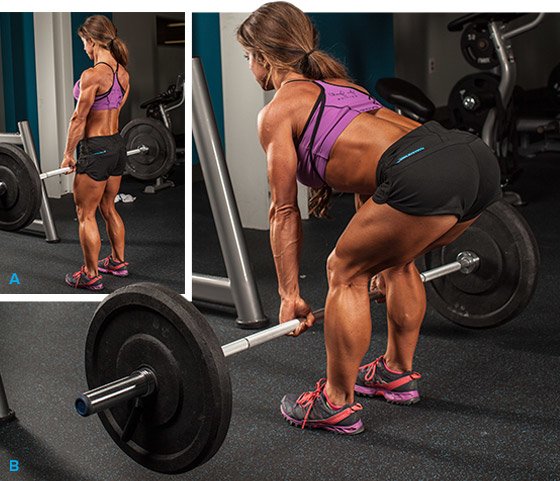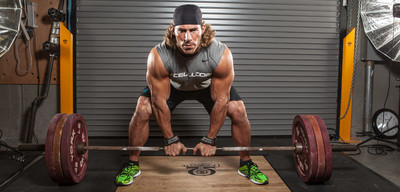"Out of sight, out of mind" may apply to the mess of clothes heaped on the floor of your closet, or the pile of overdue bills tucked away in your desk drawer, but when it comes to your physique, overlooking what you don't see in the mirror can have repercussions that affect more than just your symmetry.
No muscle group is more out of sight than the hamstrings on the rear of your thighs, so it's easy to skip them or promise yourself once again that you'll train them tomorrow. However, the hamstrings—a group of three muscles composed of the biceps femoris, the semimembranosus, and the semitendinosus—are important for more than simply improving how you look from the back.
For one, they help stabilize the knee joint, which is an important factor for any athlete—especially women, who are more prone to knee injuries as a result of weak hamstrings.[1] They're also one of the most frequently injured muscle groups among both sexes, accounting for about 25 percent of all athletic injuries.[2]
Added to these facts, research suggests that relatively weak hamstrings—as compared to the quads—may be responsible for a high incidence of hamstring strains or anterior cruciate ligament injuries.[3] For these reasons alone, it's important not to let your hamstring strength slack.
It's Hammer Time
Because weak hamstrings can lead to injury, and nonexistent hamstrings can lead to aesthetic embarrassment, these imbalances need to be taken seriously. If you're looking for ways to bring up your hamstrings, start here with these eight strategies. Incorporate one or more into your training, both for aesthetic reasons and to better stabilize your knee joint.
Ideal Hamstring Strength
For optimal knee health and joint stability, the quadriceps should be stronger than the hams by about a 3:2 ratio.
For example, if you can do 10 reps on the leg extension with 150 pounds, you should be able to complete 10 reps with 100 pounds on the lying leg curl.
Struggling to get 10 reps on the leg curls? Then the ratio of strength for these antagonistic muscles is out of whack and you may be putting yourself at risk for a knee injury.

{{caption}}
1. Rewire Your Hamstring Workout
Rearranging your workout may seem like an obvious place to start, but doing so may require a substantial rewiring of your training split. Think about it: You probably have a leg day, and it includes exercises like squats, hacks, leg presses, lunges, leg extensions, and leg curls.
But more often than not, your dedicated hamstring exercises come at the tail end of your workout when fatigue levels are high, you can barely walk, and your only thoughts are of finishing the workout and getting out of the gym. That's hardly a state that's conducive to cooking up strong hams.
But flipping your legs workout around during the short term—doing your hamstring exercises first when your energy levels are highest—can dramatically affect your rear-thigh strength gains. While you'll definitely be stronger on those ham exercises, you'll be a little weaker on exercises you shift toward the end of your workout. This is to be expected, and it's one reason the reordering is done for just the short term.

{{caption}}
Another strategy is to train your hams after a rest day. Strategically placing a rest day—during which you eat well and get plenty of sleep—before training a lagging body part can fuel you for a challenging workout. A rest day also helps refresh your mind, as motivation tends to wane when you've spent too many consecutive days in the gym and your general state of fatigue is on the rise.
You might also consider a common strategy that pro bodybuilders use: separating your hamstring workout from your quad workout. Here, you could do each workout on separate days, allowing you to put greater energy into each workout without having to do one muscle immediately after the other in a single workout.
The key here is to ensure the workouts are separated by at least 48 hours since there is some crossover—that is, the hamstrings are still doing some degree of work on exercises like squats and leg presses, so you don't want to end up doing them on back-to-back days. Inserting an upper-body workout between the two leg days better ensures ample recovery.
2. Supercharge Your Squats
While research shows the hamstrings are recruited during squatting motions, their engagement is in fact rather limited.[4] Be aware that programs built around the squat do not maximize the strength or size development of the hamstrings.
Still, you can increase the degree of muscular tension on the hamstrings during hip-extension/flexion movements—like squats—by doing a couple of things. For one, increase the depth of your squat, ensuring that your lower back doesn't round and other factors of good form are accounted for.
As you slowly descend into a squat, the muscle fibers of the quads are being stretched while those of the hamstrings—especially the semitendinosus—are being activated to help stabilize the knee joint.[5] Because the hamstrings are highly activated during the eccentric (lowering) phase of the squat, the deeper you go, the more hamstring muscle fibers you recruit.[6]
Placing your feet well out in front of the plane of your torso, as when squatting on a Smith machine, can also reduce quadriceps activation, enabling the hamstrings and glutes to work harder.
3. Go Ham First
While we normally suggest starting your workouts with a heavy compound movement, many lower-body compound movements don't cut it when you're really trying to build hamstring size and strength. Most lower-body compound lifts emphasize the quads, so start your workout with a deadlift or other hamstring-focused exercise.
A 2009 study suggested that the Russian curl (otherwise known as the floor glute-ham raise, or natural glute-ham raise on this website) was the top hamstring movement in terms of EMG activity, although that study didn't include the deadlift.[5] Based on this research, the Russian curl is probably your best bet to include in your hamstring routine if you're not deadlifting.

{{caption}}
Since this exercise is relatively difficult to master (bend at the knees, not at the hips), and it's difficult to use added weight, experiment with it as the first or last movement in your hamstring-focused workout depending on how many reps you can do. The muscle-building rep range doesn't change here; stay in the 8-12-rep range, achieving muscle failure on your last rep, for best results.
4. Load Up On Leg Curls
EMG studies show that among the various leg-curl movements like standing leg curl, seated leg curl, and Russian leg curl, each movement hits the individual muscles of the hamstrings a bit differently. In fact, that's a reason workouts are constructed with more than just one exercise. On hamstring day, it makes sense then to do multiple leg-curl exercises. The same study that reported the high ranking of the Russian leg curl also suggested that the seated leg curl was second in electrical activity.[5]
Regardless of whether you choose seated leg curls or lying leg curls, do them in a slightly different rep range than what you did with your first movement. So, if you start your workout with 8 reps, choose a resistance on your second exercise that provides a different relative intensity, such as 10-12 reps to failure.
By choosing a relatively lighter weight that works the muscle with a slightly higher rep target, you ensure the muscle gets trained in more than a single way from a single angle.
5. Work Your Hammies From The Hips
Choosing exercises to complement leg curls isn't restricted to movements in which motion takes place at the knee joint. In fact, since the hamstrings attach above the hips, movements in which you're bending over at the hip work the upper area of the hamstrings (as well as the glutes) effectively as well. You could choose a good morning exercise or, more commonly, the Romanian deadlift.

{{caption}}
Lots of folks confuse Romanians with stiff-legged deadlifts, but there are some important differences. While the stiff does recruit the hams to some degree, it's basically a lower-back exercise, not a hamstring movement, and the form is different. There's no rounding of the back with Romanians, the bar stays very close to your legs, and you don't descend much past the middle thigh (depending on your flexibility).
Learn those important distinctions so that, when you're doing a hip-joint movement for hamstrings, you choose the deadlift that most effectively targets your hamstrings.
6. Fire Past Failure
Building muscle in the shortest time possible means embracing the concept of training to failure. That means you lift until you can't do any more reps on your own with good form. Taking selective sets past muscle failure by employing intensity-boosting techniques can further boost muscle gains (but not necessarily strength). Forget about just putting the weight down when it starts to get uncomfortable; you've still got more reps to do!
Taking every set past failure is counterproductive, but you can do it with 1-2 of your heaviest sets of an exercise. Here are a few of the advanced intensity-boosting techniques at your disposal, some of which require a spotter.
Without A Partner
- Partials. You should be able to lift 90 percent of your 1RM for 3-4 reps. So if you can do 225 pounds for 3 reps, divide 225 by 0.9. Your 1RM is roughly 250 pounds.
- Dropset. As you reach muscle failure, rather than just ending your set, quickly reduce the poundage by about 25 percent and continue on to a second point of muscle failure. This is best done with pin-loaded machines, cables, and dumbbells in which you have all the right weights in place when starting your set, so you don't waste time searching.
With A Partner
- Forced Reps. Have your partner spot you on your heaviest sets, giving you just enough assistance to keep a rep going past the sticking point. This will allow you to complete a few additional reps that you otherwise wouldn't have been able to do on your own.
- Negatives. As you reach muscle failure, your partner steps in to help you lift the weight, and then you then lower it very slowly, taking a full five seconds to complete the negative contraction. Do as many reps as you can until you can no longer control the speed of the descent. This technique works especially well with machines like lying leg curls and seated leg curls.
7. Double Up On Ham
Training splits longer than about five days allow you to target a lagging body part by doing it twice over the course of your split, rather than just once. If you really want to focus on short-term hamstring growth, you can train your hammies more than once per week for 6-8 weeks.
If you choose this approach, don't simply repeat the same workout you did the first time. Your first workout could emphasize leg curls from the knee joint, and your second workout could focus on the hip joint with Romanian deadlifts.
If you train hams twice, be aware that it could affect your quad workout—and recovery—to some degree, so pay special attention to how you construct the split. Ensure there's at least 48 hours between each of your three workouts—or combine quads and hams on the same day for one of the workouts—to build in recovery time.
8. Stretch!
It's a good idea to stretch a target muscle after any workout, but it's especially important with hamstrings, given not their high incidence of injury and the relationship between tight hamstrings and lower-back pain. Tight hamstrings pull on the pelvis, contributing to misalignment that ultimately can result in low-back injury.
Nearly every longtime bodybuilder has dealt with lower-back pain at some point, and it's not to be taken lightly. A few 30-second hamstring stretches can help elongate muscle tissue that's become shortened after an intense workout.
Tip
Don't restrict your hamstrings workout to just movements in which you bend at the knees. Bending at the hips also works the upper hamstrings and is a smart complement to leg-curl movements.
References
- Arendt, E., & Dick, R. (1995). Knee injury patterns among men and women in collegiate basketball and soccer NCAA data and review of literature. The American Journal of Sports Medicine, 23(6), 694-701.
- Petersen, J., & Holmich, P. (2005). Evidence based prevention of hamstring injuries in sport. British Journal of Sports Medicine, 39(6), 319-323.
- Holcomb, W. R., Rubley, M. D., Lee, H. J., & Guadagnoli, M. A. (2007). Effect of hamstring-emphasized resistance training on hamstring: quadriceps strength ratios. The Journal of Strength & Conditioning Research, 21(1), 41-47.
- Ebben, W. P. (2009). Hamstring activation during lower body resistance training exercises. International Journal of Sports Physiology and Performance, 4(1), 84-96.
- Wright, G. A., Delong, T. H., & Gehlsen, G. (1999). Electromyographic activity of the hamstrings during performance of the leg curl, stiff-leg deadlift, and back squat movements. The Journal of Strength & Conditioning Research,13(2), 168-174.
- Jensen, R. L., & Ebben, W. P. (2000). Hamstring electromyographic response of the back squat at different knee angles during concentric and eccentric phases. In ISBS-Conference Proceedings Archive (Vol. 1, No. 1).

